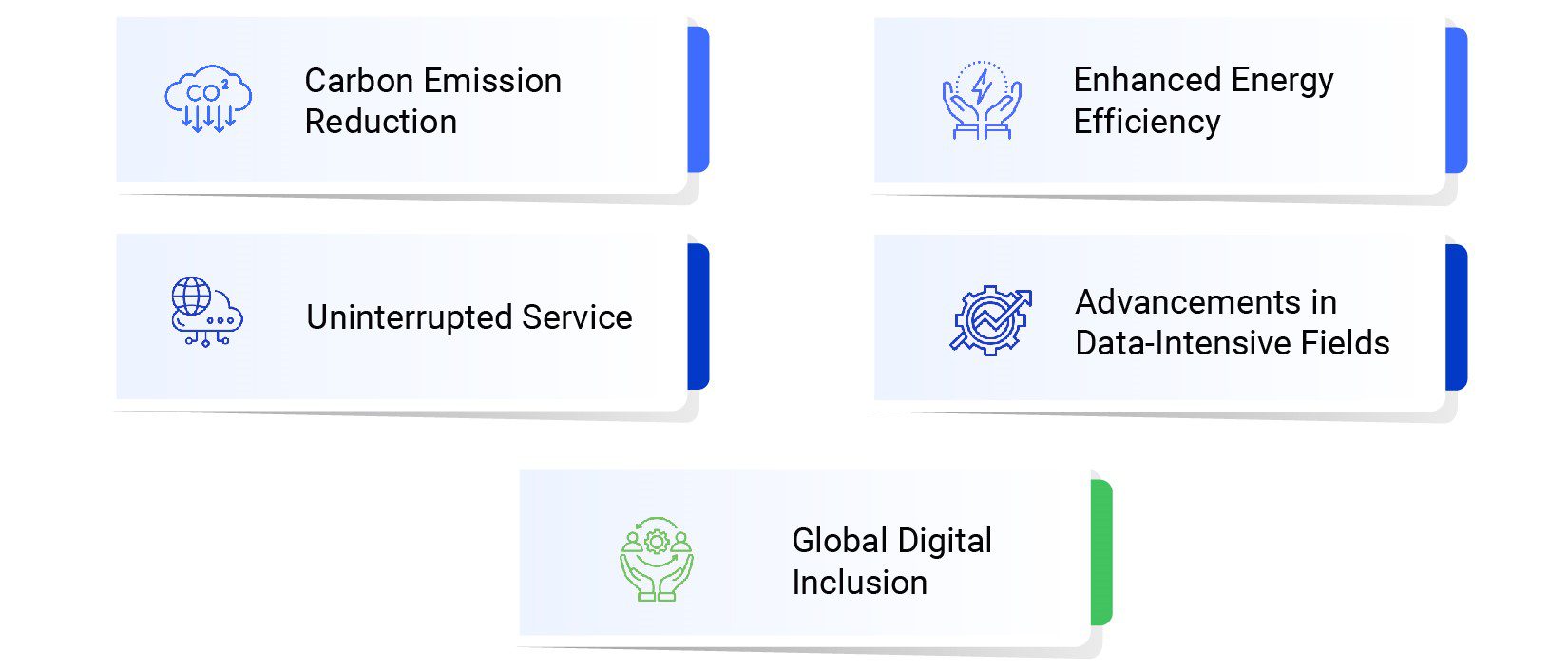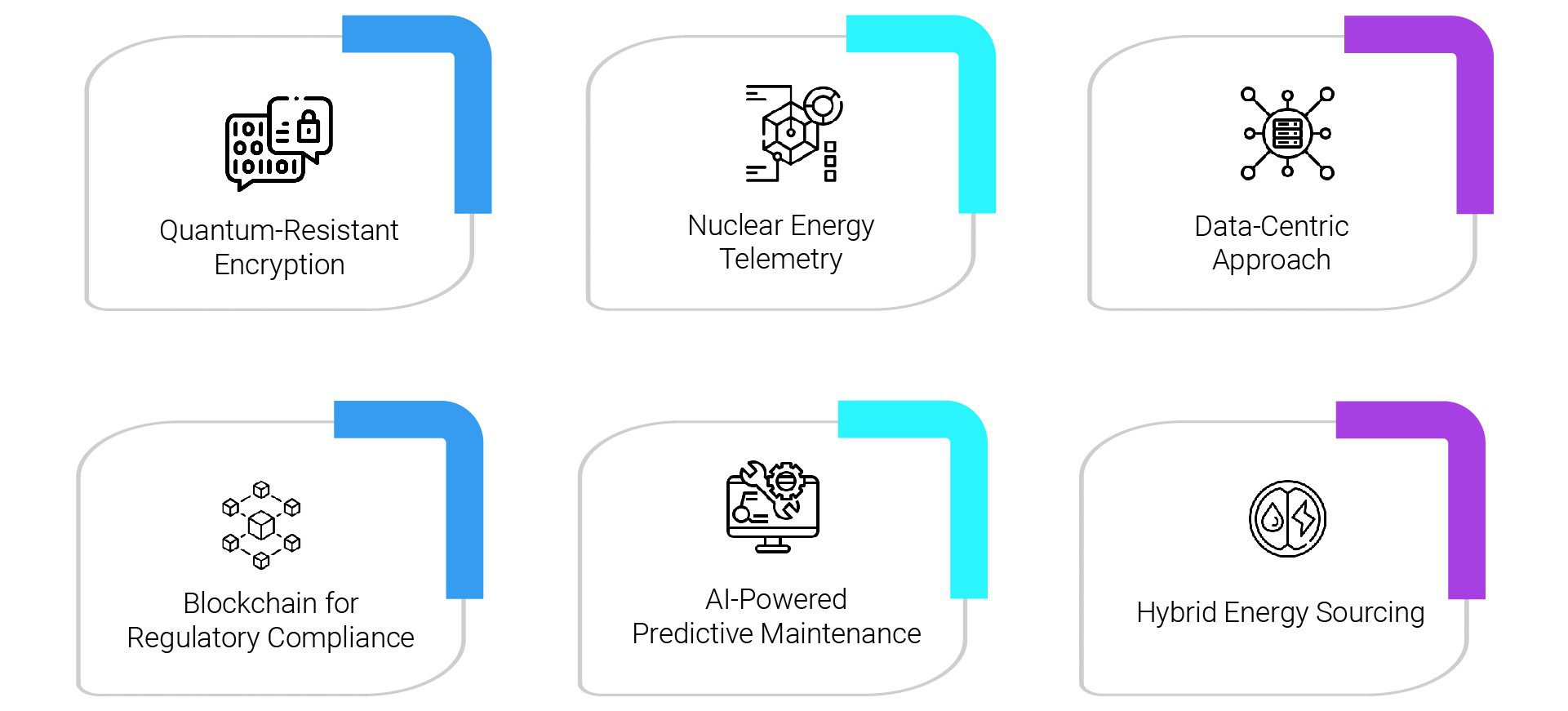Highlights:
- Nuclear-powered cloud computing is a revolutionary concept poised to transform the energy and technology landscape, offering solutions to the escalating demand for data processing while reducing the carbon footprint.
- This fusion aligns with the challenge of meeting energy demands in an eco-friendly manner, with nuclear energy’s stability and sustainability addressing these concerns.
- The energy industry must adapt its infrastructure, regulations, investments, and public perception to fully embrace nuclear-powered cloud computing.
- Microsoft stands out as a pioneering leader actively exploring nuclear-powered cloud computing, with a dedicated nuclear program manager driving its strategy.
In this Quick Byte:
In the ever-evolving landscape of technology and energy, an exciting fusion is on the horizon: nuclear-powered cloud computing. This groundbreaking concept promises not only to reshape our digital world but also to revolutionize the energy industry itself. In this blog, we will explore the fascinating realm of nuclear-powered cloud computing, unveiling the pivotal steps that the energy industry must take to prepare for this seismic shift and harness its potential to the fullest
What is a Nuclear-Powered Cloud, and Why is the Energy Industry Moving Towards It?
At its core, nuclear-powered cloud computing is a visionary concept that seeks to harmonize the extraordinary power generated by nuclear reactors with the unparalleled computational capabilities of cloud data centers. In this innovative marriage, the energy harnessed from nuclear reactions becomes the lifeblood of data processing and storage infrastructure. But what makes this fusion so compelling, and why are energy leaders and innovators eager to explore its potential?
The answer lies in the contemporary challenges facing both the digital and energy landscapes. In our increasingly interconnected world, the digital ecosystem is experiencing explosive growth in data generation and consumption. The proliferation of smartphones, IoT devices, and the burgeoning fields of artificial intelligence and machine learning have all contributed to an insatiable appetite for data processing, storage, and analysis.
However, this voracious digital expansion is not without its ecological consequences. The conventional energy sources that power enterprise data centers, such as coal and natural gas, often result in substantial carbon emissions and environmental degradation. As concerns about climate change and sustainability intensify, the energy sector faces a dual challenge: meeting the escalating energy demands of the digital age while minimizing its carbon footprint.
This is precisely where nuclear-powered cloud computing steps in as a game-changer. Nuclear energy, with its well-established track record of producing copious amounts of electricity with minimal greenhouse gas emissions, offers a potent solution to the energy requirements of data centers. The sustained power output of nuclear reactors ensures a continuous and reliable energy source, addressing the intermittency issues associated with renewables like solar and wind. Moreover, nuclear energy’s inherent environmental benefits, including its capacity to reduce carbon emissions and air pollution, align seamlessly with global sustainability objectives. By integrating nuclear power into cloud computing infrastructure, this innovative approach is poised to deliver a myriad of benefits that will reshape industries and society as a whole:

- Carbon Emission Reduction: Perhaps the most immediate and crucial transformation is the substantial reduction in carbon emissions. Traditional data centers, often reliant on fossil fuels, are major contributors to greenhouse gas emissions, accounting for about 2% of global greenhouse gas emissions. By replacing or supplementing these with nuclear-powered data centers, we can dramatically decrease the carbon footprint of the digital age. This move aligns perfectly with global efforts to combat climate change and achieve carbon neutrality. Data centers Nuclear power is a low-carbon energy source, emitting about 1 gram of carbon dioxide per kilowatt-hour of electricity generated. A 2022 study by the Breakthrough Institute found that nuclear-powered data centers could reduce carbon emissions from data centers by up to 90%.
- Enhanced Energy Efficiency: The energy efficiency gains from this fusion cannot be overstated. Nuclear reactors provide a consistent and stable energy supply, eliminating the need for power-hungry backup systems and reducing energy wastage. They have a capacity factor of over 90%, meaning they operate at full capacity over 90% of the time. Data centers, notorious for their voracious energy consumption, can become significantly more efficient, leading to cost savings and reduced environmental impact. A 2021 study by the US Department of Energy found that nuclear-powered data centers could reduce energy consumption by up to 50%.
- Uninterrupted Service: The marriage of nuclear power and data centers means that critical digital services can operate without interruption, even during power outages. Nuclear power plants are highly reliable, with a downtime of less than 1%. This level of reliability is a game-changer for businesses, governments, and organizations that rely on continuous data access for their operations. It ensures that crucial functions, such as healthcare systems, financial transactions, and emergency services, remain operational under all circumstances. A 2022 study by the World Economic Forum found that nuclear-powered data centers could reduce downtime by up to 90%
- Advancements in Data-Intensive Fields: Nuclear-powered cloud computing has the potential to catalyze innovation in fields that rely heavily on data processing. Advanced simulations, real-time analytics, and artificial intelligence-driven insights become not just accessible but also more efficient and powerful. This will accelerate progress in healthcare, scientific research, climate modeling, autonomous vehicles, and much more. A 2021 study by the National Renewable Energy Laboratory found that nuclear-powered data centers could accelerate the development of artificial intelligence by up to 10 years.
- Global Digital Inclusion: Over 3 billion people around the world do not have access to the internet. Nuclear-powered data centers can be deployed in remote areas with limited access to electricity, helping to bridge the digital divide. A 2022 study by the International Energy Agency found that nuclear-powered data centers could help to bring internet access to over 1 billion people by 2030. This fosters economic growth and digital inclusion, empowering communities that have historically lacked access to the benefits of the digital age.
As promising as nuclear-powered cloud computing may be, the energy industry must overcome several challenges to fully embrace this transformation:
- Infrastructure Upgrades: Existing data centers and power grids may need significant upgrades to accommodate the integration of nuclear power. This includes adapting data center designs, transmission lines, and distribution networks.
- Regulatory Framework: Governments and regulatory bodies must establish clear guidelines for the safe deployment of nuclear-powered cloud computing. Licensing, safety standards, and waste management protocols must be developed or adapted to accommodate this emerging technology.
- Investment: The transition to nuclear-powered cloud computing will require substantial financial investments. Energy companies, technology giants, and governments must collaborate to fund research, development, and infrastructure deployment.
- Public Perception: Overcoming public apprehension regarding nuclear energy is crucial. Effective communication and education efforts are necessary to build trust and garner support for this transformative technology.
- International Collaboration: Given the global nature of the digital ecosystem, international collaboration is essential. Countries and organizations must work together to ensure interoperability, security, and the responsible use of nuclear-powered cloud computing.
Nuclear-powered cloud computing represents an exciting frontier in the convergence of technology and sustainability. The energy industry’s readiness for this transformation hinges on its ability to adapt infrastructure, navigate regulatory challenges, secure investments, and gain public trust. By overcoming these hurdles, we can unlock the immense potential of nuclear-powered cloud computing and pave the way for a more sustainable and digitally empowered future.
Here are four government organizations currently delving into the realm of nuclear-powered cloud computing:
- The United States Government: The US Department of Energy (DOE) is funding research into the use of nuclear power to power data centers. The DOE is also working with industry partners to develop new nuclear technologies that could be used to power data centers. For example, the DOE is working with NuScale Power to develop a new type of small modular reactor (SMR) that could be used to power data centers.
- The Chinese Government: The Chinese government is also funding research into the use of nuclear power to power data centers. The Chinese government is also interested in using nuclear power to create carbon-free energy grids. For example, the Chinese government is developing a new type of high-temperature gas-cooled reactor (HTGR) that could be used to power data centers and create carbon-free energy grids.
- The Russian Government: The Russian government is also interested in using nuclear power to power data centers. The Russian government is developing a new type of SMR that could be used to power data centers. For example, the Russian government is developing the RITM-200 SMR, which is a 200 MW reactor that could be used to power data centers and other remote facilities.
- UK Government’s Nuclear for Net Zero Program: In 2023, the UK government launched a program called the Nuclear for Net Zero program. The Nuclear for Net Zero program is designed to support the development and deployment of nuclear power for a variety of applications, including cloud computing. The UK government is also working with a number of companies that are developing nuclear-powered cloud computing technologies. For example, the UK government is working with Natrium Energy to develop the Natrium Cloud platform.
Strategic Preparations for Nuclear-Powered Cloud Computing: Paving the Path to Success
The journey towards embracing nuclear-powered cloud computing is a monumental undertaking that demands meticulous preparations. Energy companies, at the nexus of energy innovation and digital transformation, must tread this path with foresight and precision. Here, we delve into the crucial preparations, exploring each step in depth:

- Quantum-Resistant Encryption: As energy companies venture into the uncharted territory of nuclear-powered cloud computing, securing data becomes paramount. What sets this apart is the need for quantum-resistant encryption. Quantum computers, with their immense processing power, pose a potential threat to traditional encryption methods. Energy companies should invest in post-quantum encryption techniques to safeguard sensitive nuclear and cloud data against future quantum attacks.
- Nuclear Energy Telemetry: Real-time telemetry and monitoring of nuclear reactors are vital for safety and performance. Innovative technologies such as distributed sensor networks and edge computing can provide granular insights into reactor conditions. This data not only ensures safety but can also optimize reactor operations for cloud computing needs, enhancing energy efficiency and computational performance.
- Data-Centric Approach: In the era of big data, adopting a data-centric approach is paramount. Innovative data management solutions, such as data virtualization and data lakes, should be explored. These technologies enable the efficient storage, retrieval, and analysis of vast quantities of nuclear and cloud data. Furthermore, federated data management systems can seamlessly integrate data from nuclear operations with cloud-based analytics, empowering energy companies to extract valuable insights and optimize both energy and computational resources. This data-centric approach ensures that data becomes a strategic asset rather than a challenge in the nuclear-powered cloud computing ecosystem.
- Blockchain for Regulatory Compliance: Blockchain technology can revolutionize regulatory compliance in the nuclear-powered cloud computing sphere. By creating immutable and transparent records of all nuclear data transactions, blockchain ensures that regulatory requirements are met seamlessly. It also enhances trust among regulators, energy companies, and the public by providing an auditable and tamper-proof ledger of all nuclear activities within the cloud.
- AI-Powered Predictive Maintenance: Nuclear reactors demand rigorous maintenance schedules. AI-powered predictive maintenance goes beyond conventional approaches. It leverages machine learning to analyze vast datasets from nuclear operations and cloud computing infrastructure. This innovation enables energy companies to predict equipment failures, optimize maintenance schedules, and prevent costly downtime, ensuring uninterrupted cloud services.
- Hybrid Energy Sourcing: An innovative approach involves the integration of nuclear power with other renewable energy sources within the cloud infrastructure. Smart energy grids and dynamic load management can balance energy consumption between nuclear and renewables. During periods of excess nuclear energy, it can be used for energy-intensive cloud computations, promoting sustainability and cost-efficiency.
Microsoft’s Vision for Nuclear-Powered Cloud Computing
Microsoft is pioneering a groundbreaking vision for nuclear-powered cloud computing, poised to revolutionize the energy landscape. At the heart of this innovative journey is a vision where small modular nuclear reactors (SMRs) and microreactors supply clean, dependable energy to power Microsoft’s expansive network of data centers. These next-gen nuclear solutions, inherently more agile and scalable than their predecessors, promise to underpin the digital world by offering a sustainable energy source.
To bring this vision to life, Microsoft is actively recruiting a nuclear technology specialist who will be at the forefront of integrating SMRs and microreactors into data center infrastructure. This strategic step underscores the gravity of Microsoft’s commitment and its determination to lead the way toward a sustainable, AI-driven future. Microsoft recognizes that AI is central to the future of cloud computing, and nuclear power is essential for fueling the next generation of AI applications. Speaking of AI, Microsoft’s investment in OpenAI, a pioneering AI technology developer, harmonizes seamlessly with this vision.
Here’s where Data Dynamics enters the equation. Their strategic partnership with Microsoft Azure signifies a critical advantage for energy companies embarking on their journey into nuclear-powered cloud computing. This collaboration represents the fusion of Data Dynamics’ specialized data management expertise with the formidable capabilities of Microsoft Azure’s expansive cloud infrastructure. Together, they offer energy companies an end-to-end solution tailored to their unique needs.
Energy companies venturing into nuclear-powered cloud computing will confront complex data management challenges due to the scale and intricacy of nuclear operations. Data Dynamics steps in as a crucial ally by ensuring efficient collection, storage, organization, and security of data generated by nuclear operations within Azure’s cloud environment. This ensures that energy companies can harness the data they produce for operational excellence and data-driven decision-making.
Microsoft Azure, with its global network of data centers and scalable infrastructure, provides the foundation upon which energy companies can build their nuclear-powered cloud computing solutions. It not only meets the computational demands of energy-intensive tasks but also offers the flexibility to adapt computing and storage resources as needs evolve, a pivotal feature as nuclear-powered cloud computing applications expand and data processing demands surge.
In essence, the Data Dynamics-Microsoft Azure partnership empowers energy companies to embrace nuclear-powered cloud computing confidently and with agility. It revolutionizes data management, scalability, security, and sustainability, positioning energy companies at the forefront of innovation, resilience, and environmental responsibility in the realm of nuclear-powered cloud computing. The journey from visionary ambition to practical execution has never been more seamless.
Click here to learn more and discover the path to intelligent cloud migration. Reach out to us at solutions@datdyn.com or give us a call at (713)-491-4298, and we’ll be there to guide you through every step. The future is at your fingertips!






